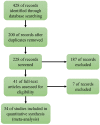A Meta-Analysis of Influencing Factors on the Activity of BiVO4-Based Photocatalysts
- PMID: 37630936
- PMCID: PMC10458677
- DOI: 10.3390/nano13162352
A Meta-Analysis of Influencing Factors on the Activity of BiVO4-Based Photocatalysts
Abstract
With the continuous advancement of global industrialization, a large amount of organic and inorganic pollutants have been discharged into the environment, which is essential for human survival. Consequently, the issue of water environment pollution has become increasingly severe. Photocatalytic technology is widely used to degrade water pollutants due to its strong oxidizing performance and non-polluting characteristics, and BiVO4-based photocatalysts are one of the ideal raw materials for photocatalytic reactions. However, a comprehensive global analysis of the factors influencing the photocatalytic performance of BiVO4-based photocatalysts is currently lacking. Here, we performed a meta-analysis to investigate the differences in specific surface area, kinetic constants, and the pollutant degradation performance of BiVO4-based photocatalysts under different preparation and degradation conditions. It was found that under the loading condition, all the performances of the photocatalysts can be attributed to the single BiVO4 photocatalyst. Moreover, loading could lead to an increase in the specific surface area of the material, thereby providing more adsorption sites for photocatalysis and ultimately enhancing the photocatalytic performance. Overall, the construct heterojunction and loaded nanomaterials exhibit a superior performance for BiVO4-based photocatalysts with 136.4% and 90.1% improvement, respectively. Additionally, within a certain range, the photocatalytic performance increases with the reaction time and temperature.
Keywords: BET; BiVO4-based composites; degradation efficiency; kinetic constant; meta-analysis.
Conflict of interest statement
The authors declare that they have no known competing financial interest or personal relationship that could have appeared to influence the work reported in this paper.
Figures






References
-
- Singla S., Devi P., Basu S. Highly Effectual Photocatalytic Remediation of Tetracycline under the Broad Spectrum of Sunlight by Novel BiVO4/Sb2S3 Nanocomposite. Catalysts. 2023;13:731. doi: 10.3390/catal13040731. - DOI
-
- Paul B., Patnaik U., Sasidharan S., Murari K.K., Bahinipati C.S. Fertilizer Use, Value, and Knowledge Capital: A Case of Indian Farming. Sustainability. 2022;14:12491. doi: 10.3390/su141912491. - DOI
-
- Ahemed J., Pasha J., Rao D.V., Kore R., Gade R., Bhongiri Y., Chetti P., Pola S. Synthesis of New Zn (II) Complexes for Photo Decomposition of Organic Dye Pollutants, Industrial Wastewater and Photo-Oxidation of Methyl Arenes under Visible-Light. J. Photochem. Photobiol. A Chem. 2021;419:113455. doi: 10.1016/j.jphotochem.2021.113455. - DOI
Publication types
Grants and funding
LinkOut - more resources
Full Text Sources

